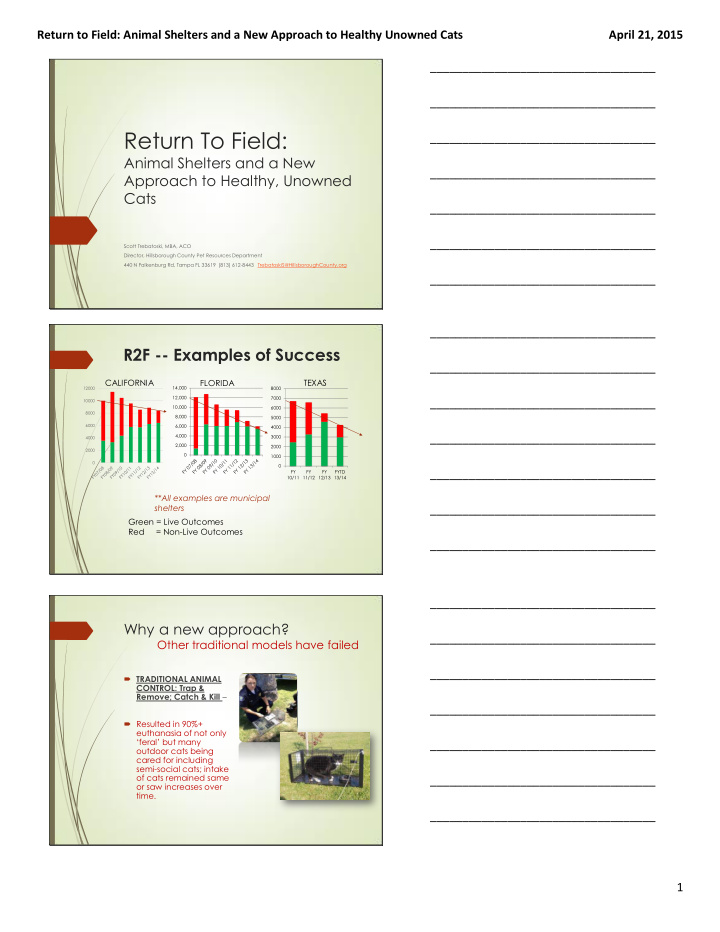



Return to Field: Animal Shelters and a New Approach to Healthy Unowned Cats April 21, 2015 ___________________________________ ___________________________________ Return To Field: ___________________________________ Animal Shelters and a New ___________________________________ Approach to Healthy, Unowned Cats ___________________________________ ___________________________________ Scott Trebatoski, MBA, ACO Director, Hillsborough County Pet Resources Department 440 N Falkenburg Rd, Tampa FL 33619 (813) 612-8443 TrebatoskiS@HillsboroughCounty.org ___________________________________ ___________________________________ R2F -- Examples of Success ___________________________________ CALIFORNIA FLORIDA TEXAS 12000 14,000 8000 12,000 7000 ___________________________________ 10000 10,000 6000 8000 8,000 5000 6000 6,000 4000 4,000 ___________________________________ 3000 4000 2,000 2000 2000 0 1000 0 0 ___________________________________ FY FY FY FYTD 10/11 11/12 12/13 13/14 **All examples are municipal shelters ___________________________________ Green = Live Outcomes Red = Non-Live Outcomes ___________________________________ ___________________________________ Why a new approach? ___________________________________ Other traditional models have failed ___________________________________ TRADITIONAL ANIMAL CONTROL: Trap & Remove; Catch & Kill – ___________________________________ Resulted in 90%+ euthanasia of not only ‘feral’ but many ___________________________________ outdoor cats being cared for including semi-social cats; intake of cats remained same ___________________________________ or saw increases over time. ___________________________________ 1
Return to Field: Animal Shelters and a New Approach to Healthy Unowned Cats April 21, 2015 ___________________________________ Why a new approach? ___________________________________ Other traditional models have failed ___________________________________ TRADITIONAL ANIMAL WELFARE: Relocation & Creation of Colonies ___________________________________ Resulted in large nuisance colonies that created backlash from animal control; longer- ___________________________________ term damage was that communities became resistant to new alternatives ___________________________________ **public focused only on large examples and nuisances they created. ___________________________________ ___________________________________ Why Return to Field Works ___________________________________ Once committed to the R2F concept, animal control begins education and nuisance abatement ___________________________________ rather than removal Decentralized: Traditional large colonies are not necessary (1000s of small groups versus 100s of large) ___________________________________ No ‘vacuum effect’ or increase in births to fill the void & attrition experienced Underground network becomes ‘above the board’ ___________________________________ and can be utilized to help with education and nuisance abatement Additional resources from welfare agencies help ___________________________________ offset start costs- ultimately cost of R2F is lower than increasing animal intake #s ___________________________________ ___________________________________ Challenges ___________________________________ Public policy officials • Veterinary community ___________________________________ • Audubon/Birders • PETA • ___________________________________ Some public health • officials Perceived legal issues • ___________________________________ Publicity can actually hurt • ‘Our community is • different’ ___________________________________ Do not eliminate all rules • for owned cats! ___________________________________ 2
Return to Field: Animal Shelters and a New Approach to Healthy Unowned Cats April 21, 2015 ___________________________________ Commonly Seen Benefits ___________________________________ Lower annual intake of cats/Lower Euthanasia ___________________________________ Less need for cat housing space – new opportunities for shelter ___________________________________ Actual shortages of cats for adoptions at times – really helps get the long-timers out ___________________________________ Reduced nuisance calls for animal control officers (with time) ___________________________________ Greater good will – shelter seen as innovative, life-savers Major increase in employee morale & ___________________________________ retention ___________________________________ Quick Look at One Success ___________________________________ Story: ___________________________________ ___________________________________ ___________________________________ ___________________________________ ___________________________________ ___________________________________ Results at a Glance ___________________________________ ___________________________________ Cat euthanasia -- 2007: 88.6% 2013: 8.5% Cat Intake -- 2007: 12,082 2013: 4,939 ___________________________________ Cat Sterilization -- 2007: 90%/10% 2013: 30%/70% [public/private] ___________________________________ Budget -- 2007: $5.6 M 2013: $3.3 M Employees -- 2007: 72 2013: 38 ___________________________________ ___________________________________ 3
Return to Field: Animal Shelters and a New Approach to Healthy Unowned Cats April 21, 2015 ___________________________________ ___________________________________ Questions? ___________________________________ ___________________________________ ___________________________________ Scott Trebatoski, Director ___________________________________ Hillsborough County (FL) Pet Resource Center TrebatoskiS@HillsboroughCounty.org ___________________________________ 4
Recommend
More recommend